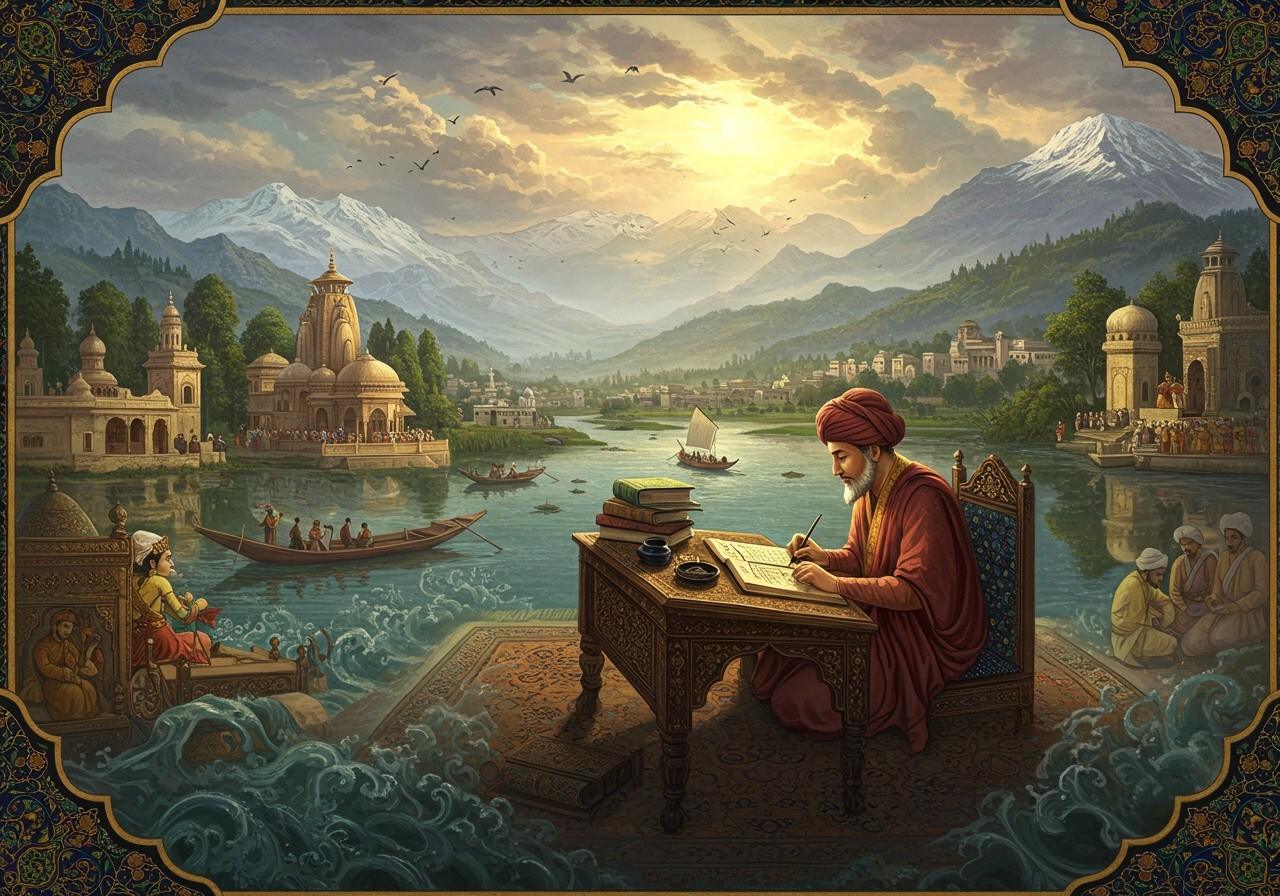
Kashmir, a land of captivating beauty and rich cultural heritage, finds its story eloquently told in the ancient text ‘Rajatarangini.’ Composed by the Kashmiri historian Kalhana in the 12th century, this Sanskrit chronicle offers a detailed exploration of Kashmir’s historical journey. By delving into the ‘Rajatarangini,’ we unearth the narratives of dynasties, rulers, and pivotal events that have molded this culturally vibrant region. This blog post will explore how this remarkable text continues to illuminate Kashmir’s enduring legacy.
What is Rajatarangini?
‘Rajatarangini,’ translating to ‘River of Kings,’ serves as a historical chronicle of Kashmir’s rulers and their eras. It comprises eight books, referred to as ‘Tarangas,’ meticulously detailing the region’s history from mythical origins up to the 12th century. Kalhana’s work masterfully interweaves oral traditions with archival research, presenting a captivating narrative of Kashmir’s past. His innovative approach to historical writing, characterized by a critical and comprehensive methodology, laid the groundwork for modern historiography.
What Makes Rajatarangini Famous?
‘Rajatarangini’ captivates readers with its rich depictions of ancient Kashmir’s political landscape, cultural nuances, and social fabric. This extraordinary text stands as a primary source for historians, offering invaluable insights into the region’s past. Kalhana’s work sheds light on administrative systems, religious practices, and the daily lives of the people. His evocative descriptions of Kashmir’s natural splendor and strategic significance have inspired countless poets and scholars. Kalhana’s poetic style imbues his historical narrative with a unique charm, painting a portrait of Kashmir that transcends mere events and captures its very essence in flowing Sanskrit verse. While some historians advocate caution in using ‘Rajatarangini’ as a sole historical source due to its literary embellishments, its status as an invaluable cultural treasure remains undisputed.
The Meaning of Rajatarangini
The title ‘Rajatarangini,’ meaning ‘River of Kings,’ aptly encapsulates the continuous flow of history. Like a river, it meanders through the tales of rulers and their reigns, contributing to Kashmir’s ongoing narrative. Kalhana’s work reflects on the ephemeral nature of power and the impermanence of human endeavors. These philosophical undertones elevate the text beyond a mere historical document, transforming it into a literary masterpiece. Kalhana’s rich poetic expression adds layers of meaning to his narrative. The allegorical content within ‘Rajatarangini’ invites readers to explore deeper themes, offering insights into life’s impermanence and the cyclical nature of time.
Kalhana: The Historian and Poet
Kalhana, the author of ‘Rajatarangini,’ was not only a historian but also a court poet with a discerning eye for detail. His motivation for compiling this historical account stemmed from a profound desire to preserve Kashmir’s legacy. Drawing upon oral traditions and meticulous archival research, Kalhana crafted a comprehensive and critical narrative. His approach to historiography was groundbreaking, emphasizing analysis and the use of multiple sources. Despite the challenges of reconciling conflicting accounts, Kalhana’s unwavering dedication is evident. His work set a precedent for future historians in South Asia.
The Enduring Legacy of Rajatarangini
The influence of ‘Rajatarangini’ extends far beyond its written pages. It has shaped Kashmir’s historical narrative and left an indelible mark on Indian historiography as a whole. Over the centuries, interpretations of the text have evolved, reflecting the changing cultural landscape. For the people of Kashmir, ‘Rajatarangini’ fosters a sense of identity and historical continuity. It serves as a cultural touchstone, linking the past to the present. In contemporary discussions about heritage, ‘Rajatarangini’ maintains its relevance, particularly amidst Kashmir’s socio-political complexities. By engaging with this remarkable chronicle, we honor Kashmir’s vibrant history, ensuring that its stories continue to inspire future generations.
How Poojn.in Connects You to Kashmir’s Sacred Heritage
Poojn.in offers a curated selection of items that connect you to Kashmir’s rich spiritual heritage, as depicted in the Rajatarangini. Here’s how we support your cultural journey:
Sacred Items for Kashmiri Rituals
- Pure copper and brass items: Perfect for traditional Kashmiri pujas, these items add authenticity to your rituals.
- Authentic kumkum and chandan: Sourced from trusted origins, these are essential for various Kashmiri ceremonies.
- Special puja thalis: Designed according to Kashmiri customs, these thalis enhance your devotional practices.
Ananda Kosha Kushi (Pure Copper)
Copper Kosha Kushi for Puja
Embracing the Legacy
As we conclude our exploration of this timeless chronicle, ‘Rajatarangini’ stands not merely as a historical record but as a guiding light illuminating the rich tapestry of Kashmir’s heritage. Kalhana’s work, with its poetic elegance and historical depth, bridges the past and the present, reminding us of Kashmir’s enduring spirit. For those who cherish tradition and seek a deeper connection with their roots, ‘Rajatarangini’ offers a profound journey through time. By engaging with its verses, we celebrate the resilience and beauty of Kashmir’s history, inspiring us to cherish our heritage and transmit its wisdom to future generations. Whether you are a history enthusiast or a lover of literature, ‘Rajatarangini’ promises to enrich your appreciation for the cultural legacy of this remarkable land.


